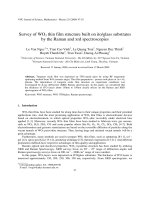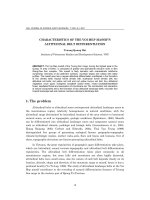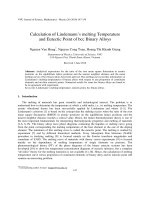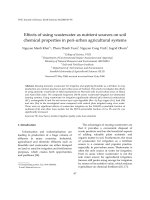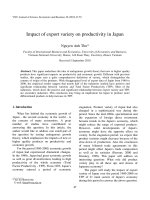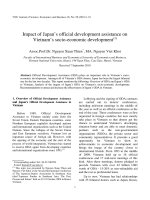Báo cáo "Impact of Japan’s official development assistance on Vietnam’s socio-economic development " pptx
Bạn đang xem bản rút gọn của tài liệu. Xem và tải ngay bản đầy đủ của tài liệu tại đây (116.61 KB, 10 trang )
VNU Journal of Science, Economics and Business 26, No. 5E (2010) 1-10
1
Impact of Japan’s official development assistance on
Vietnam’s socio-economic development
(1)
Assoc.Prof.Dr. Nguyen Xuan Thien
*
, MA. Nguyen Viet Khoi
Faculty of International Business and Economics,University of Economics and Business,
Vietnam National University, Hanoi, 144 Xuan Thuy, Cau Giay, Hanoi, Vietnam
Received 7 September 2010
Abstract. Official Development Assistance (ODA) plays an important role in Vietnam’s socio-
economic development. Amongst all of Vietnam’s ODA donors, Japan has been the largest bilateral
one for the last two decades. This report mentions the following: Overview of ODA and Japan’s ODA
to Vietnam; Analysis of the impact of Japan’s ODA on Vietnam’s socio-economic development;
Recommendations to attract and increase the effectiveness of Japan’s ODA in Vietnam.
1. Overview of Official Development Assistance
and Japan’s Official Development Assistance to
Vietnam
*
Before 1989, Official Development
Assistance to Vietnam mainly came from the
Soviet Union, Eastern European countries, some
Northern European capitalist developed nations
and international organizations such as the United
Nations. Since the collapse of the Soviet Union
and East European socialism, Vietnam lost an
important source of foreign aid. However, with
the opening of the economy and the start of the
process of world integration, Vietnam has started
to receive ODA again from developing countries
and international organizations since 1993.
(1)
______
*
Corresponding author.Tel.: 84-912189554
E-mail:
(1)
This topic was presented by Nguyen Xuan Thien and
Nguyen Viet Khoi at the Second International Conference
of The Japanese Studies Association in Southeast Asia
titled "Japanese Studies in Southeast Asia: The Past,
Present and Future" held on 22-23 October 2009 in Hanoi,
Vietnam.
Lobbying and the signing of ODA contracts
are carried out in donors’ conferences,
including mid-term meetings in the middle of
the year as well as an official conference at the
end of the year. These conferences were at first
organized in foreign countries but now mostly
take place in Vietnam so that donors get the
chance to understand Vietnam’s developing
situation better and are able to meet domestic
partners such as the non-governmental
organizations (NGOs), the private sector and
community representatives. It presents a good
opportunity for Vietnam to show its
achievements in economic development and
brings the image of the country closer to
international friends. From 1993 to the middle
of 2009, Vietnam held up to 16 official
conferences and 17 mid-term meetings of this
kind. After these meetings, donors pledged to
provide Vietnam with over 42 billion USD
worth of ODA - 15-20% as non-refundable aid
and the rest as preferential loans.
Up to now, Vietnam has had relationships
with 25 bilateral donors such as Japan, Korea,
N.X. Thien, N.V. Khoi / VNU Journal of Science, Economics and Business 26, No. 5E (2010) 1-10
2
Australia, Sweden, Switzerland, France, Canada
and England, 22 of which are annual donors.
Vietnam has also established multilateral
relations with 15 international organizations
such as the Asian Development Bank (ADB),
the World Bank (WB), the European
Commission (EC) and the International Finance
Corporation (IFC). Besides, Vietnam also
cooperates with more than 350 NGOs which
provide an average of 80 million USD in non-
refundable aid. Our major donors are Japan, the
WB and the ADB, whose funding is
approximately 70% of total committed ODA.
Japan alone accounts for 40% of total aid. Other
partners such as the EC, UNDP, France and
Oxfam (Great Britain) have also carried out
effective activities in various fields, especially
centering on poverty reduction, community
development and human resource improvement.
As mentioned, Japan is the largest donor to
Vietnam since 1993. Japan’s total ODA in the
period 1993 to 2005 was 1,167.1 billion yen of
which 13.27 % were in the form of grants and
86.77% in the form of preferential loans. The rate
of preferential loan disbursement was 40.15%.
EY
Source: Vietnam ministry of planning and investment
Figure 1: The Top ODA Donors in Vietnam in 2008.
Vietnam also receives aid from Japan through
technical assistance between Japan-ASEAN,
Japan-GMS (Greater Mekong Sub-region), and
Japan–Indochina agreements. For instance, Japan
financed 20 million USD for the Indochina
triangle’s development scheme (the junction of
Vietnam-Laos-Cambodia) via the Japan-ASEAN
Integration Fund, which was committed at the
Japan-Mekong Foreign Ministers’ meeting in
January, 2008.
Source: Vietnam ministry of planning and investment
Figure 2: Commitment and Disbursement of Japan’s ODA to Vietnam.
0
20
40
60
80
100
120
Yen billion
Total
59.5 66 82.1 92.4 96.5 100.8 112 86.4 91.6 92.4 91.7 94.6 100.9
Grand aid
7.3 8.1 12.1 11.4 11.5 12.8 10.7 15.5 17.3 13.1 12.4 12.6 10.1
ODA loans (committed)
52.3 58 70 81 85 88 101.3 70.9 74.3 79.3 79.3 82 90.8
ODA loans (Disbursed)
1.16 1.76 4.9 21.2 29.2 74.7 63.9 37.2 29.8 55 66.5 61.2
1993 1994 1995 1996 1997 1998 1999 2000 2001 2002 2003 2004 2005
80
85
90
90
101
115
228
250
287
1,112
1,120
1,350
- 200 400 600 800 1,000 1,200 1,400
million USD
Australia
Denmark
Germany
UN
UK
USA
France
NGO
Korea
Japan
WB
ADB
N.X. Thien, N.V. Khoi / VNU Journal of Science, Economics and Business 26, No. 5E (2010) 1-10
3
At the moment, Japan's aid to developing
countries has declined due to ongoing economic
problems. In the meantime, however, Vietnam
remains Japan’s preferred aid recipient.
Japan's new policy on providing ODA for
Vietnam in the upcoming years will focus on
the following areas:
- Promoting growth including: improvement
of the investment environment, development of
small and medium enterprises as well as the
private sector, transportation, energy and
power, telecommunications, human resources,
and economic reforms such as the reform of
state-owned enterprises.
- Improving living standards and conditions
including the areas of education, healthcare,
rural development, urban development,
environmental concerns and living standards
and conditions.
- Enhancing institutions including
improvements in the legal system and
administrative reforms.
2. Analysis of the impact of Japanese Official
Development Assistance on Vietnam’s socio-
economic development
In recent years, ODA has been an effective
source of support for Vietnam’s development,
especially as Vietnam is still a poor country and
needs to attract outside capital to achieve its
economic goals, namely the processes of
innovation, industrialization and modernization.
Between 1996 and 2000, Japan’s ODA
accounted for 12% of total social investment
capital, the equivalent of 24% of total
investment capital from the budget or 50% of
state credit capital for development and
investment. (An overview of ODA in Vietnam,
Ministry of Planning and Investment, Social-
Economic Information 2003).
ODA to Vietnam has two main goals:
supporting socio-economic development,
poverty alleviation and administrative reforms.
3. Supporting socio-economic development and
poverty alleviation
ODA has played a vital part in the
considerable success of Vietnam’s socio-
economic development and poverty alleviation.
These goals are also highly agreeable with the
international donor community and
governments, for example, Vietnam’s
comprehensive strategies on growth and
poverty alleviation and millennium
development objectives between 2001 and
2010. To achieve these goals, ODA’s allocation
should focus on the following areas:
a) Infrastructure development
On a large scale, ODA has been intensively
invested in both national and local
constructions such as national highways,
provincial roads, port upgrades, hydropower
plant systems and high voltage power transfers.
Until the end of 2003, ODA projects have
helped Vietnam to restore, upgrade and build
3676 km of highways, about 1,000 km of
provincial highways, and 188 main bridges on
the national highways with a total length of
33.7 km. Among these projects, many are very
important such as the No. 5 route linking Hanoi
to Hai Phong, and the national highway 1A
from Hanoi to Vinh and Ho Chi Minh City to
Can Tho and Nha Trang. Other major projects
have also been implemented such as My Thuan
Bridge, the Hai Phong and Sai Gon seaport
upgrade, the Cai Lan deep-water port
construction, the Tien Sa and Da Nang port
restoration, the construction of many electric
factories such as Phu My 1, Phu My 2, Ham
Thuan-Da Mi, Song Hinh, Nhim, Pha Lai 2, Tra
Noc et cetera, and the 500 kV North-South line
as well as the 220KV line installation from
Playku-Phu Lam to Tao Dan-Nha Be.
According to joint research conducted in
2003 between the Japanese School of Policy
Research and the Vietnamese Ministry of
Planning and Investment, major ODA projects
conducted in the 90s greatly impact economic
N.X. Thien, N.V. Khoi / VNU Journal of Science, Economics and Business 26, No. 5E (2010) 1-10
4
growth and poverty alleviation by connecting
development centers to rural areas of Vietnam.
In fact, these connections enable the rural
access to social services and attract investment,
stimulating economic growth in rural areas.
At the local level, small ODA projects such
as the development of power, roads, schools
and stations or water supply and waste
treatment projects are very practical and helpful
in improving local standards of living. ODA
also helped to renovate 10,000 km of roads and
31 km of rural bridges and expanded the
electricity network to over 30 provinces and
cities. Besides support in the development of
simple infrastructure, ODA projects have
helped to develop many key and modern
constructions such as the upgrading of Bach
Mai Hospital (Hanoi) and Cho Ray Hospital
(Ho Chi Minh City). Moreover, ODA has
effectively supported many programs related to
urban development such as transport
infrastructure upgrades, safe water supply, and
sanitation and waste treatment.
b) Development of education and training
and implementation of social programs
ODA projects are mostly used for important
social programs such as population and
development programs, vaccination programs,
children’s nutrition programs, initial healthcare
programs and HIV/AIDS and drug prevention
programs.
Until the end of 2003, ODA projects for
education and training reached about 550-million
USD (accounting for 8.5% of total expenditure on
education), which has helped improve the quality
and effectiveness of Vietnam’s education system
and enhanced technical facilities. Such assistance
progressively modernizes Vietnam’s education
system in order to help it catch up with education
standards in the region. Particularly, most ODA
projects for education and training were provided
in the form of non-refundable aid through
independent technical cooperation projects. (An
overview of ODA in Vietnam, Ministry of
Planning and Investment, Socio-economic
Information, No.12 (24) 2003, p. 24).
With regards to social development, at a
world conference on social development
organized by the United Nations in Copenhagen
in 1995, Vietnam joined The Idea 20/20, which
allocated 20% of the total budget and 20% of total
ODA for basic social services. These efforts were
reconfirmed by developing countries and the
international donor community in the Hanoi
Consensus meeting on the Initiative 20/20 on June
10
th
, 1998. Vietnam became one of the first
developing countries to increase investment in
basic social services, especially on healthcare and
education programs.
In implementation of the Idea 20/20, a
report in 1999 on basic social services in
Vietnam, compiled by the UNDP and the
Vietnam Government, indicated that the state
budget for basic social services had
continuously increased since 1990 and had
reached 17.1% in 1997 (8.5% of the UN’s
standards). Assistance in basic social services
reached 10% of United Nations standards in
1997 (UNDP, UN and Government Joint effort
to protect basic social service spending, 10
December 1999).
c) Socio-economic development in
agricultural, rural and areas of extremely
difficult circumstances
Investment in agriculture and rural
development in Vietnam mainly comes from
the following sources: 1) Taxes on agricultural
land used for construction in rural areas 2)
Capital funding from the locals for the
construction of infrastructure in rural areas, and
3) ODA from foreign countries.
Thus, it can be clearly seen that ODA is an
important source of funding for agricultural and
rural development. Up to early 2004, there have
been 156 new projects funded by a total amount
of more than 1.4 billion USD of ODA,
especially in the forms of preferential credit
granted to farmers to create side employment,
encourage agriculture and fishing and develop
rural infrastructure. (A general view on ODA in
Vietnam, Economy - Society News, 12
th
(24)
publication 2003, page 24).
N.X. Thien, N.V. Khoi / VNU Journal of Science, Economics and Business 26, No. 5E (2010) 1-10
5
ODA has positively supported hunger
elimination and poverty alleviation programs
including priority programs such as Program 135
on economic development for communities
existing under extremely difficult circumstances,
Program 133 on the development of northern
mountainous provinces, the 5-million-hectare
Forest Program, the Initiative of Central Provinces
on Lightning and Natural Calamity and so on.
4. Supporting reforms
The second biggest aim of ODA is to
support holistic reform and innovation to create
an open market economy in Vietnam. This has
always been the priority of sponsors such as
Japan. For example, according to the
framework of the Miyazawa Initiative, Japan
granted ODA to Vietnam to support private
area development, audit state-owned
enterprises, and convert non-tariff trade barriers
into tariff trade barriers. Under Vietnam’s
operation strategy in 1995, the ADB regarded
policy reform and institutional development as
its first priority while most of ODA granted by
the World Bank was in the form of structural
adjustment credit.
Since 2001, in addition to regular aid, all
sponsors have pledged to a special kind of aid
to enhance and stimulate reform in Vietnam. In
general, ODA supporting reform in Vietnam
focuses on the following fields:
a) Policy and institutional aid
The goal is to plan a method of deployment,
progress assessment, and supervision of the
process of policy implementation, especially
that relating to reform efforts as well as hunger
elimination and poverty alleviation. For
instance, ODA helps to carry out the studying,
planning and assessment of socio-economic
development programs, holistic strategies on
growth, hunger elimination and poverty
alleviation, and Vietnam’s millennium
development goals. Moreover, this activity also
helps to evaluate the efficiency of aid projects
and programs, especially with respect to
community participation in policy design for
development.
b) Structural adjustment and economic reform
The main point of this particular target is to
provide technical support and advice on
planning and deployment of the first stage of
reformation projects for state-owned economic,
banking and private sectors, especially for small
and medium developing enterprises.
c) Administrative and legal reform
Administrative reforms are the biggest
concerns of the ADB, UNDP, Denmark,
Sweden, Germany, and Holland, among others.
Many projects on technical and financial
support are proposed and deployed to assist
administrative reforms in Vietnam, including
the planning and implementation of general
programs on administrative state reforms over
the 2001 - 2010 period. Two basic aspects of
this program are exchange of traditions and
customs and policy dialogue.
In the field of legal reform, sponsors are
positively supporting a general strategy on legal
reform to be issued in 2007 which focuses on
the following four aspects: 1) Principles and
framework to be used in developing the
economy and civilian society 2) Institutions and
the Constitution 3) Law education and
specialized training 4) Income transparency and
diffusion of information on the law. (Report on
Vietnam development in 2002: Implementing
reform to poverty alleviation and quicker
growth, World Bank Vietnam, page 64, 2003)
Together with support in the planning process
for the general program in state administration
and legal reform programs for the 2001 - 2010
period, ODA also helps to reform and upgrade the
quality of the administration and law system by
assisting in staff development, promoting good
practices in budget allocation, clarification and
simplification of administrative procedures,
issuing legal documents, encouraging the
community to take part in the planning of
development policy, and promoting dialogue and
N.X. Thien, N.V. Khoi / VNU Journal of Science, Economics and Business 26, No. 5E (2010) 1-10
6
development-partnership mechanisms among
sponsors, community, non-governmental
organizations, enterprises and the government.
5. Recommendations to attract and increase
the effectiveness of Japan’s ODA in Vietnam
5.1. ODA management
The ineffective administrative system is the
main obstacle to ODA management, which
slows down the implementation of investment
projects. There are several common concerns
including:
- Slow land clearance due to improper
planning, inappropriate compensation and
corruption.
- Lack of reciprocal capital or late
allocation of reciprocal capital. The main
reason for this is inadequate budget. However,
due to misallocation as well, there is still
inessential spending on attracting ODA
measures, which require funds.
- Late procurement due to lack of
transparent organizational processes and the
“request-give” regime resulting in time-
consuming and under-table lobbying.
- Incomprehensive administrative
procedures in ODA projects, especially with
regards to tax procedures.
- Personnel inefficiency
- Failure to provide seamless access to
capital, especially for the private sector due to
the centralized management of ODA
However, there are also some problems on
the part of the donors, such as:
- Incompatibility of priorities or regulations
on types of aid with Vietnam’s situation and
conditions. Many donors make decisions
without referring to Vietnamese partners or
conducting studies into feasibility. Some are
motivated by political interests.
- Difficulty of fund allocation when different
donors have different priorities. There are repeat
receivers and transportation cost increases
dramatically due to diseconomies of scale.
- Unclear sponsorship regulations of some
donors
- Although almost all donors have pledged
to invest in the private sector and provide
assistance to every organization, most projects
are actually executed only by the government
and its offices. In contrast, NGOs and
companies in the private sector have few
chances to cooperate with donors, except by
participating in meetings.
- The donors have not found specific
methods to assess the effectiveness of projects,
leading to dishonest acts by some partners and
incomplete programs. Most projects do not take
into consideration long-term issues and lack of
coordination.
In dealing with these problems, the Prime
Minister signed the 17/2004/CT-TTg decree on
speeding up ODA disbursement. This paper
mentioned two issues: ODA institutional reform
based on reviewing the 17/CP decree on
managing and using ODA and the
establishment of an intra-ministerial working
group to evaluate the implementation of ODA
projects. There are also other suggestions to
improve the quality of managing and using
ODA in Vietnam. The following are some
measures focusing on basic issues:
- Enhancing ODA management capacity:
focusing on officers’ qualification and
administrative reform from the central to the
local level. The Ministry of Planning and
Investment is trying to complete a program to
strengthen ODA management capacity, which
attaches special importance to institutional
reform and human resources.
- Diversifying forms of funding: in addition
to aiding through projects, other forms of non-
project funding in long-term programs, which
embrace all fields and link with other areas,
should be encouraged and attracted.
- Besides the function of an important
source of capital for development assistance
capital, ODA should be exploited in terms of
N.X. Thien, N.V. Khoi / VNU Journal of Science, Economics and Business 26, No. 5E (2010) 1-10
7
providing policy consulting for the government
by donors such as how to write polices,
decentralize power, reform the economy and
allocate budgets prudently. It is a useful tool for
Vietnam’s development in the long term.
- Avoid a passive attitude of dependence on
foreign assistance, step up the effectiveness of
using ODA and fight against corruption.
- Harmonize and simplify capital
management and disbursement processes.
Vietnam should work out an appropriate model
of practice to those involved including
government, donors and receivers.
- In particular, Vietnamese authorities
should narrow the gap between donors and
Vietnam in order to attract more capital.
Though the main target of international
assistance is hunger elimination and poverty
alleviation, most donors and the Vietnamese
government emphasize on the sustainability of
such capital as well as the quality of economic
growth. Foreign donors are often very
interested in Vietnam’s effort in reforming the
economy, particularly in state-owned
companies and the banking system.
- Finally, ODA should be made available to
private businesses, NGOs and community
organizations. This is because these groups are
in real need of capital. This also contributes to
the anti-corruption process and the removal of
red tape from the administrative system.
5.2. Measures for attracting and speeding up
Official Development Assistance disbursement
Attracting ODA has many advantages such
as a stable political and social environment,
high economic growth, and integration into the
world economy and the region as a full member
of the WTO. Besides, the institutional and legal
environment has been improved to gradually
meet international standards, subsequently
consolidating and expanding cooperation
between Vietnam and international donors.
The achievements in cooperation and
development have been extremely encouraging.
However, the speed of implementation of ODA
projects has still been very slow and the
disbursement has not yet met given
requirements. It is expected that total disbursed
ODA in 2007 was about $2 billion, surpassing
the target of 5%. Yet, in comparison with the
requirements of ODA disbursement, only $3.9
billion was disbursed from 2006 to 2007, the
equivalent of 32% of the total expected ODA
disbursement in the period 2006 - 2010. This
implies that there is a need to work out suitable
methods to speed up the process in the
remaining three years so as to reach the planned
total of $11.9 billion of ODA.
This situation has brought about concerns
voiced by the Vietnamese government and
donors. Regarding policies, the government has
issued guidelines to attract and use ODA so that
ministries, branches and localities can mobilize
ODA based on these guidelines to achieve
preferred targets. A legal system on ODA
management and use has been developed in a
fairly complete, consistent and synchronized
way. Implementing the Hanoi Core Statement,
donors comply with the plan of developing
Vietnam’s economy and society when
providing ODA, which is consistent with
branches’ and localities’ orientations in
development.
However, attracting and using ODA have
not lived up to these expectations because of
some shortcomings. Firstly, Vietnam’s process
and internal procedures for ODA management
and use are still complex and not transparent
which hinders the projects’ preparation and
implementation. Secondly, some regulations of
the Vietnamese government and donors are not
congruous, especially in matters of
immigration, land clearance and bidding.
Thirdly, the capacities for managing and
organizing projects are still weak, especially at
the local level. These current weaknesses are
challenging to the authorities in the context of a
strongly decentralized evaluation and approval
process of projects at the Ministry and
provincial People’s Committee level.
N.X. Thien, N.V. Khoi / VNU Journal of Science, Economics and Business 26, No. 5E (2010) 1-10
8
While these shortcomings have been
overcome, there are still insufficiencies that
need to be resolved to achieve breakthroughs in
the implementation and disbursement of ODA.
5.3. Using Official Development Assistance to
enhance the capacity of implementing projects
In most ODA projects, strengthening
capacity of implementation always plays a vital
role in achieving projects’ targets. Today, except
in infrastructural projects, the rate of spending for
enhancing capacity is always approximately 50%
of total budget for the whole project or even
higher. It appears that this trend may continue in
the next five to ten years.
Strengthening capacity in ODA projects
always comprises two closely related issues:
management capacity and technological
capacity (including both technological skills
and non-technological job skills). Other
researchers have added other kinds of capacity,
such as interpersonal skills and the ability to
work with agencies and social organizations.
Thus, different types of capacities can be
divided into many ways based on different
approaches and standards of classification.
Enhancing capacity also consists of
improvement in people’s awareness and
building skills for all officers in the whole
system. To achieve this target, there should be a
comprehensive environment in which
everybody has a chance to show their skills and
their ability to apply them under pressure. This
environment should also create favorable
conditions for the process of capacity transfer
between individuals in the
community/organizations. It will motivate
everyone to improve themselves constantly
based on essential skills they have been trained
in directly or indirectly.
Therefore, capacity should be seen from
different aspects. Improving capacity is a highly
systematic process which takes a long time.
Only when the comprehensiveness and multi-
dimensional nature of implementation of
projects are guaranteed can this target be
reached. Until now, while much research has
been carried out to define the standards of
evaluation of a successful project, there are still
very few studies about good criteria of
enhancing the capacities of the above-
mentioned.
Capacity enhancement targets in most ODA
projects are detailed by principles and ratios
which are decided by experts. The ratios focus
on the following fields:
- The capacity of key individuals involved
in the project, mostly referring to their
improved intellect and awareness as well as
their attitudes and behaviors.
- The capacity of organizations related to or
in charge of the projects, for example: recipient
organizations and those supplying goods and
services for the project's activities.
- The working environment of individuals
and organizations including their coordination
mechanisms and newly-established
relationships in the project.
ODA projects have truly provided offices
and organizations with projects which have
been improving their capacity in many fields.
Still, there are some weaknesses:
- Many of the capabilities that came about
or were improved by projects dissipate or
become redundant.
- In many organizations, new capabilities
did not complement each other and thus, could
not be promoted.
- Activities to improve capacity are not
maintained regularly. Therefore, the outcome of
these activities is hard to predict.
- Many of the improved elements prove to
be incompatible with current situations of
recipient organizations and lead to wastage of
resources or even become a liability to the
organizations.
- In some cases, the improvements are not
compatible with the true demands of
organizations which have accepted and
benefited from the projects.
N.X. Thien, N.V. Khoi / VNU Journal of Science, Economics and Business 26, No. 5E (2010) 1-10
9
The causes of the weaknesses listed above
include:
- Inaccurate research and evaluation processes
of demands lead to wrong evaluations of demand
which can result inaccurate planning of projects
such as impossible targets and solutions.
- Unsuitable project management
mechanisms not only in administration and
implementation but also the initial
conceptualization and reflection of the project.
Some staff are stated to be the best in their field
for the respective projects as assigned by their
organizations. However, sponsors refuse to give
aid to these very staff, which prevents smooth
coordination. Still, many organizations providing
goods and services are able to be employed and
improve themselves in the progress of the project.
When the project ends, these organizations work
for other organizations, causing a decrease in
relative capability of the organization taking over
the project.
- Capacity improvement projects did not
come up with solutions to ensure compatible
conditions for the organizations subsequently
taking over the projects in order to maintain and
develop capabilities produced after the end of
the project.
- These projects only focus on improving a
single organization at a time. Recently,
sponsored aid based on programs seemed to
have made better improvements and a more
systematic way of solving problems. However,
in order to improve and make use of its
capacity, more improvements are needed with
respect to the systems utilized in projects.
The exploitation and use of these capacities
depends on many other factors especially the
environment, targets set and methods of
utilization. In order to level up the effectiveness of
improvements in capacity of ODA projects,
organizations that take over the projects need to:
- Decide on the key element to focus on (with
respect to the subject of improvement). Today, the
ability of basic units is considered the center of
the project. According to the current situation in
Vietnam, focusing on improving key units and
staff does not mean ignoring other elements, but
concentrating on maximizing the usage of
resources. Therefore, when carrying out projects,
organizations need to analyze the capabilities of
the whole system to highlight the strongest and
weakest aspects. This is however less of a concern
in today's projects.
- Choose the right factor to improve. For
different individuals and organizations, the need
to improve capabilities can be different. On a
practical level, technical abilities, new
technology and knowledge are necessary. On a
strategic level, general ideas and strategic issues
and approaches are needed (in the form of the
way to approach and solve problems within the
scope of the responsibilities of those involved)
- In designing projects, targets for
improvement need to be clear, suitable, detailed
and practical. Besides, the supervision and
evaluation of individual and organizations'
activities are also important to help
management keep track of the results of the
usage and implementation of the various
capabilities.
- Build and implement management
improvement programs at the same time
(including administrative innovation) to enable
officers to apply knowledge and skills that they
have been trained in. Besides, these officers
need to be aware of the importance of the
project so that they themselves can see the
effectiveness of these measures.
- Improving the ability of selected
individuals is an important target of many ODA
projects in Vietnam. However, in recent years,
these activities have not worked out as
expected. In order to level up the effects of
these projects, besides improving ability and
administration, there needs to be a greater
awareness on the part of individuals who wish to
improve. This ought to be distinguished from
other needs including a system's ability, the ability
to evaluate technical, administrative and
communicative abilities as well as other elements
including knowledge, skills, awareness and
motivation of those related correctly.
N.X. Thien, N.V. Khoi / VNU Journal of Science, Economics and Business 26, No. 5E (2010) 1-10
10
6. Conclusion
The Japanese government is Vietnam’s
number one bilateral donor. Its ODA has
greatly contributed to Vietnamese economic
development through poverty alleviation
processes. In 2010, GDP per capita in Vietnam
may reach 1,000 USD, taking Vietnam off the
list of low-income countries. Yet, Vietnam is
still at the bottom of poverty line and has to deal
with many challenges in developing the economy
due to the consequences of past wars. It is hoped
that the Japanese government continues to provide
large amounts of ODA to Vietnam in the next
decade. Non-refundable aid could be decreased
gradually but it should be substituted by increase
in other types of favorable loans for infrastructure
construction such as highways and the North-
South railway in Vietnam.
The increase in ODA from Japan will
strengthen trade relationships between the two
countries and draw more Japanese FDI to
Vietnam as well as boost sustainable and long-
term, mutually beneficial strategic partnerships.
References
[1] Co-assessment on common budget supporting:
Report on Vietnam. Ministry of Planning and
Investment. Hanoi, 2007.
[2] Economic Integration and ODA Allocation,
Department for multilateral Economic Cooperation,
Ministry of Foreign Affairs, Hanoi, 2004.
[3] Economic Information, Vietnam News, 2007
and early 2008.
[4] National Strategy on Development, Hunger
Elimination and Poverty Alleviation, Ministry of
Planning and Investment, 2003.
[5] Seminar on Japan’s ODA Procedures in
Vietnam. Ministry of Planning and Investment,
October 2007.
[6] Sinh Viet Cao, Orientations to attracting and
using ODA for the 2006-2010, Economic and
Forecast Magazine. No 1- 2008.
[7] Overview of ODA in Vietnam, National Center for
Socio - Economic Information & Forecast (NCEIF),
Ministry of Planning and Investment December
2003.
[8] Websites of Vietnam’s Ministry of Planning and
Investment, and General Statistic Office.
Tác động của nguồn vốn hỗ trợ phát triển chính thức của Nhật
Bản đối với sự phát triển kinh tế - xã hội Việt Nam
PGS.TS. Nguyễn Xuân Thiên*, ThS. Nguyễn Việt Khôi
Khoa Kinh tế và Kinh doanh Quốc tế, Trường Đại học Kinh tế,
Đại học Quốc gia Hà Nội, 144 Xuân Thủy, Cầu Giấy, Hà Nội, Việt Nam
Tóm tắt: Nguồn vốn hỗ trợ phát triển chính thức (ODA) đóng một vai trò quan trọng đối với sự
phát triển kinh tế - xã hội của Việt Nam. Trong hai thập kỷ vừa qua, Nhật Bản là nước cung cấp nguồn
vốn hỗ trợ phát triển chính thức lớn nhất cho Việt Nam. Bài viết này đề cập tới những nội dung chính
như sau: Đánh giá chung về tình hình nguồn vốn hỗ trợ phát triển chính thức và nguồn vốn hỗ trợ phát
triển chính thức của Nhật cho Việt Nam; Phân tích tác động của nguồn vốn hỗ trợ phát triển chính
thức của Nhật đối với sự phát triển kinh tế - xã hội Việt Nam; Đề xuất khuyến nghị thu hút và nâng
cao hiệu quả nguồn vốn hỗ trợ phát triển chính thức của Nhật tại Việt Nam.
